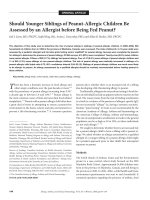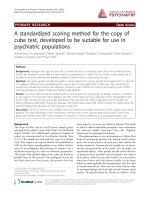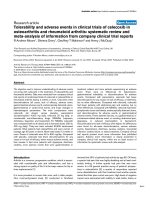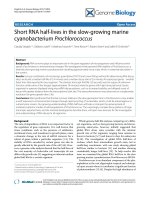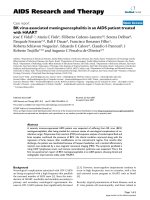Báo cáo y học: "Should dialysis be offered in all cases of metformin-associated lactic acidosis" pot
Bạn đang xem bản rút gọn của tài liệu. Xem và tải ngay bản đầy đủ của tài liệu tại đây (38.44 KB, 2 trang )
Available online />Page 1 of 2
(page number not for citation purposes)
Abstract
Metformin is commonly used in diabetes mellitus type 2, with lactic
acidosis being a rare but potentially fatal complication of this
therapy. The management of metformin-associated lactic acidosis
(MALA) is controversial. Treatment may include supportive care,
activated charcoal, bicarbonate infusion, hemodialysis, or continuous
venovenous hemofiltration. In the previous issue of Critical Care,
Peters and colleagues systematically evaluated outcomes in MALA
patients admitted to their intensive care unit. The mortality rate of
patients who received dialysis was similar to that of patients who
were not dialyzed. However, it was the more acutely and
chronically ill patients who actually received dialysis. This suggests
that hemodialysis was beneficial in preventing a higher mortality
rate in those who required renal replacement therapy.
The literature on the management of metformin-associated
lactic acidosis (MALA) is sparse and consists of case reports
and case series. In the previous issue of Critical Care, Peters
and colleagues [1] presented a retrospective cohort study in
patients with MALA. This study represents an important step
forward in systematically evaluating outcomes in this rare but
serious condition.
Metformin is commonly used in type 2 diabetes mellitus and
accounts for approximately one third of all prescriptions for
oral hypoglycemic agents in the US [2]. The United Kingdom
Prospective Diabetes Study demonstrated impressive
reductions in diabetes-related endpoints and mortality in
overweight patients with type 2 diabetes who used this drug
[3]. A rare but extremely serious adverse effect of this
medication is lactic acidosis, which carries a staggering 50%
mortality rate [4].
Metformin is renally cleared and is known to accumulate in
patients with chronic kidney disease [4]. Current guidelines
stipulate that it be used with caution in estimated glomerular
filtration rates (eGFRs) of less than 60 mL/minute and not at
all in eGFRs of less than 30 mL/minute [5]. Identified risk
factors for MALA include acute kidney injury (AKI), hypoxe-
mia, sepsis, alcohol abuse, liver failure, myocardial infarction,
and shock [6]. Medications that interfere with renal hemo-
dynamic autoregulation (that is, angiotensin-converting
enzyme inhibitors, angiotensin receptor blockers, and non-
steroidal anti-inflammatory drugs) and volume depletion are
frequently implicated in generating the AKI leading to MALA
[4]. The incidence of MALA is quoted at 1 to 5 cases per
100,000 patient-years but may be as high as 30 cases per
100,000 patient-years [4].
The mainstay of MALA therapy is supportive care. Particular
attention should be paid to normalizing the acid-base im-
balance, eliminating offending medication, and treating
concomitant disease [4]. Activated charcoal may also have a
role, especially in cases of metformin overdose [6]. Intra-
venous sodium bicarbonate is commonly used to correct
blood pH. Renal replacement therapies, including conven-
tional hemodialysis and continuous venovenous hemo-
filtration, have been successfully employed in MALA [6-11].
These allow for both isovolemic correction of the metabolic
acidosis as well as removal of metformin and lactate [4].
Peters and colleagues [1] performed a 5-year retrospective
review of all patients admitted to their intensive care unit
presenting with MALA. They defined MALA as lactic acidosis
(lactate of greater than 5 mmol/L and bicarbonate of less than
22 mmol/L) occurring in a patient who was chronically taking
metformin or in the setting of a metformin overdose. No
patients actually had MALA as their admission diagnosis.
Most were admitted for management of shock or acute renal
failure. MALA was part of the clinical presentation in this
patient cohort rather than an admission diagnosis. MALA
Commentary
Should dialysis be offered in all cases of metformin-associated
lactic acidosis?
S Neil Finkle
Capital Health, 5089 Dickson Centre, 5820 University Avenue, Halifax, Nova Scotia, Canada, B3H 1V8
Corresponding author: S Neil Finkle,
Published: 9 January 2009 Critical Care 2009, 13:110 (doi:10.1186/cc7161)
This article is online at />© 2009 BioMed Central Ltd
See related research by Peters et al., />AKI = acute kidney injury; eGFR = estimated glomerular filtration rate; MALA = metformin-associated lactic acidosis.
Critical Care Vol 13 No 1 Finkle
Page 2 of 2
(page number not for citation purposes)
accounted for 0.84% of all admissions and demonstrated a
30% mortality rate. Eighty percent of these patients
developed acute renal failure and 62.5% required hemo-
dialysis. Only one patient with normal renal function was
dialyzed because of severe acidosis.
The definition of MALA in this study did not duly account for
people presenting primarily with tissue hypoperfusion as the
likely cause of their lactic acidosis. Although metformin may
interfere with lactate clearance in a shock state, it is not
thought to be the primary cause of the acidosis. Restoration
of hemodynamic stability rather than dialysis is the goal of
therapy in these cases. Most of the patients who died in this
study were admitted with shock, suggesting that hypo-
perfusion, rather than metformin, was the principal cause of
their lactic acidosis. However, MALA itself can present with
hypotension due to negative inotropic effects and increased
systemic vascular resistance with acidosis [4,6].
The mortality rate in MALA was not altered by hemodialysis.
This may be a reflection of the small size of this study. Upon
closer inspection of the data, those patients who were
dialyzed were more acutely ill as they had higher values on
the SAPS II (Simplified Acute Physiology Score II). Further-
more, those who were dialyzed trended toward having a
larger burden of comorbidity (Charlson index) and more
severe acidosis. These data strongly suggest that hemo-
dialysis may be of benefit in MALA. This is in keeping with the
available literature.
Competing interests
The author declares that he has no competing interests.
References
1. Peters N, Jay N, Cravoisy A, Barraud D, Nace L, Bollaert PE,
Gibot S: Metformin-associated lactic acidosis in intensive care
unit. Crit Care 2008, 12:R149.
2. Wysowski DK, Armstrong G, Governale L: Rapid increase in the
use of oral antidiabetic drugs in the United States, 1990-2001.
Diabetes Care 2003, 26:1852-1855.
3. Garber MD: Metformin: mechanisms of antihyperglycemic
action, other pharmacodynamic properties, and safety per-
spectives. Endocr Pract 1997, 3:359-370.
4. Prikis M, Mesler EL, Hood VL, Weise WJ: When a friend can
become an enemy! Recognition and management of met-
formin-associated lactic acidosis. Kidney Int 2007, 72:1157-
1160.
5. Canadian Diabetes Association Clinical Practice Guidelines
Expert Committee: Canadian Diabetes Association 2008 clini-
cal practice guidelines for the prevention and management of
diabetes in Canada. Can J Diabetes 2008, 32:S1-S201.
6. Spiller HA, Sawyer TS: Toxicology of oral antidiabetic medica-
tions. Am J Health Syst Pharm 2006, 63:929-938.
7. Guo PY, Storsley LJ, Finkle SN: Severe lactic acidosis treated
with prolonged hemodialysis: recovery after massive over-
doses of metformin. Semin Dial 2006, 19:80-83.
8. DePalo VA, Mailer K, Yoburn D, Crausman RS: Lactic acidosis.
Lactic acidosis associated with metformin use in treatment of
type 2 diabetes mellitus. Geriatrics 2005, 60:36, 39-41.
9. Lalau JD, Westeel PF, Debussche X, Dkissi H, Tolani M, Coevoet
B, Temperville B, Fournier A, Quichaud J: Bicarbonate haemo-
dialysis: an adequate treatment for lactic acidosis in diabetics
treated by metformin. Intensive Care Med 1987, 13:383-387.
10. Bruijstens LA, van Luin M, Buscher-Jungerhans PM, Bosch FH:
Reality of severe metformin-induced lactic acidosis in the
absence of chronic renal impairment. Neth J Med 2008, 66:
185-190.
11. Nyirenda MJ, Sandeep T, Grant I, Price G, McKnight JA: Severe
acidosis in patients taking metformin—rapid reversal and sur-
vival despite high APACHE score. Diabet Med 2006, 23:432-
435.
